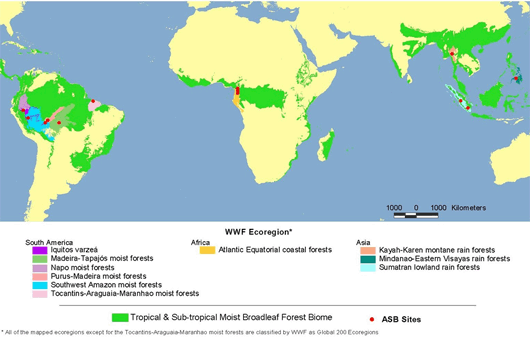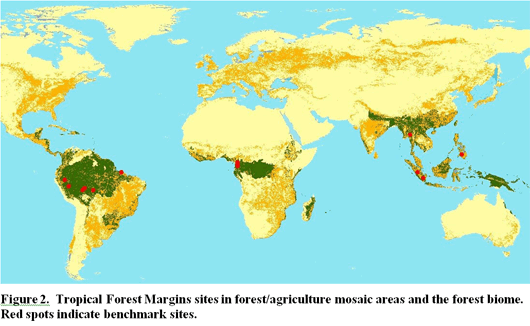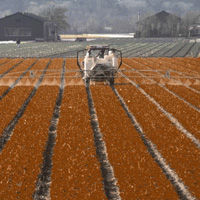
Alternatives to Slash-and-Burn
Forest and Agroecosystem Tradeoffs in the Humid Tropics (Tropical Forest Margins) Crosscutting Sub-Global Assessment
Project Summary
The Tropical Forest Margins sub-global assessment (SGA) was the first crosscutting SGA in the Millennium Ecosystem Assessment (MA). It draws on ten years of research from the benchmark sites of the ASB-Partnership for Tropical Forest Margins. The sites are located in ecoregions in the Peruvian Amazon, the western Amazon of Brazil, an associated site in the eastern Amazon of Brazil, the Congo Basin of Cameroon, northern Thailand, and the islands of Sumatra in Indonesia and Mindanao in the Philippines. The assessment focuses on the landscape mosaics (comprising both forests and agriculture) where global environmental problems and poverty coincide at the margins of the remaining humid tropical forests.
This assessment considers the impact of all drivers of deforestation and environmental degradation in the forest margins. Drivers of deforestation include not only migrant smallholders, who practice slash- and-burn agriculture, but also plantation owners, other medium- and large-scale farmers, ranchers, loggers and state-run enterprises and projects.
All of the benchmark sites of the ASB-Partnership for Tropical Forest Margins are located in the humid tropical broadleaf forest biome (Figure 1). These sites are critical biodiversity and poverty hotspots and all are listed as WWF priority ecoregions for the tropics. The ecoregions where these sites are located have the richest terrestrial vegetation in the world, and conversion of these forest areas leads to greater species loss per unit area than any other type of land cover change. Studies indicate that 1.8 billion people, most directly dependent upon forest resources and agriculture for their livelihoods, live within the humid tropical forest biome.
The ASB Partnership has been researching tropical forest margins since 1994. Upon joining the MA, the ASB Partnership adopted MA scenarios and a greater participatory component into its programme. The ASB Partnership will continue to build on the results it attained both during and prior to the MA assessment. The Tropical Forest Margins MA results will be used to help identify research priorities, policy options, and land-use strategies to improve natural resource management both locally and globally. Results are aimed at policy-makers and decision-makers dealing with land use in tropical countries.
Assessment Approach
The ASB benchmark sites are areas (roughly ranging from one hundred to one thousand square kilometers) of long-term study and engagement by ASB partners with households, communities, and policy-makers at various levels. Community-level assessments were a key part of the Tropical Forest Margins assessment process. Production of guidelines and most of the field work and interviews were conducted within several communities in each benchmark area.
Time frame
- Pilot assessment: 2003
- Main assessment: 2004
- Review and outreach, project completion: 2008
Lead Institutions
ASB-Partnership for Tropical Forest Margins is a system-wide programme of the Consultative Group on International Agricultural Research (CGIAR). The six national and six international institutions involved are: Agency for Agricultural Research and Development (AARD), Indonesia; Empresa Brasileira de Pesquisa Agropecuária (Embrapa), Brazil; Institut de Recherche Agricole pour le Dévéloppement (IRAD), Cameroon; Instituto Nacional de Investigación Agraria (INIA), Peru; Philippine Council for Agriculture, Forestry and Natural Resources Research and Development (PCARRD), Philippines; and Royal Forest Department (RFD), Thailand; Center for International Forestry Research (CIFOR), Centro Internacional de Agricultura Tropical (CIAT), the Tropical Soil Biology and Fertility Institute (TSBF), International Food Policy Research Institute (IFPRI), International Institute for Tropical Agriculture (IITA), and The World Agroforestry Centre (ICRAF). The World Agroforestry Centre is ASB-Partnership’s convening centre and hosts the global coordination office in Nairobi, Kenya.
Contact Information
- ASB Global Coordinator
c/o ICRAF
PO Box 30677
Nairobi 00100 Kenya
Tel: +254 20 7224000
via USA +1 650 833 6645
Fax: +254 20 7224001
via USA +1 650 833 6646
asb@cgiar.org
Funding for this work was provided by grants from the Millennium Ecosystem Assessment, the World Bank-Netherlands Partnership Programme and the government of the Netherlands. Core support was provided by CGIAR, the World Agroforestry Centre and the Earth Institute of Columbia University. ASB partners funded the project with in-kind contributions.
Ecosystem Services Assessed
- Provisioning services: food, fodder, fiber, water, timber, non-wood forest products, etc.
- Regulating services: carbon sequestration, atmospheric regulation, air quality, water supply, nutrient supply, regulation of crop pests and diseases.
- Resource base and supporting services: soils, biological diversity, ecological knowledge.
- Related topics: ecosystem resilience, human well-being, tradeoffs between ecosystem services and human well-being, driving forces of land use.
Project Outputs and Results

Figure 1. Tropical Forest Margins benchmark sites and their forest biomes. All of the mapped ecoregions, except Tocantis-Araguaia-Maranhao moist forests, are classified by WWF as Global 200 Ecoregions.

Figure 2. Tropical Forest Margins sites in forest/agriculture mosaic areas and the forest biome. Red spots indicate benchmark sites.
Results of the ASB-Partnership for Tropical Forest Margins assessment indicate that it is extremely difficult to strike an equitable balance between the legitimate interests of development and equally legitimate global concerns over the environmental consequences of tropical deforestation. ASB- Partnership will continue to review the results of its work and engage in dialogue and consultation with stakeholders to identify user needs and prepare ASB-Partnership for Tropical Forest Margins policy briefs on policy-relevant questions. These policy briefs will then be collated into a comprehensive assessment report.
The majority of the substantive material used in this assessment was drawn from ASB-Partnership research and publications, which now number more than 800. This assessment has synthesized that vast body of information, placing the ASB-Partnership results within a broader scientific context and making them more accessible to relevant parties, especially decision-makers.
The MA facilitated increased participatory research and brought to the ASB-Partnership a new tool: scenarios. Commitment to developing and using scenarios is high within the ASB-Partnership.
Scenarios
Few of the partners in the ASB-Partnership had prior experience with scenarios before the Tropical Forest Margins assessment. A global training and participatory scenario exercises programme was developed as part of the Tropical Forest Margins assessment, but further training is necessary for capacity building in using scenarios. The following scenarios were developed in association with the assessment.
In Northern Peru, two scenario exercises were developed with students of secondary schools, higher education technical students, and technicians from the Sustainable Development Mountain Ecosystem Programme to develop and build awareness on how the ecosystem can be preserved in the watershed.
In the Madre de Dios and Ucayali, in the Peruvian Amazon, scenarios were used to explore and raise awareness on the environmental, social and economic implications of the new transoceanic road that connects the Amazon of Brazil and Peru crossing biodiversity hotspot areas.
Cameroon landscape scenarios were developed with community members at the village level. The scenarios were based on the time scale: 1970, 2000 and 2030. In this particular case, results of the scenarios were inconsistent with scientific findings.
Brazil regional and local scale scenarios used an economic model to test the effects of devaluation on a landscape/forest area in Brazil. Results were used for informing policy-making in the Brazilian Enterprise for Agriculture and Livestock Research (Embrapa). Results are available in IFPRI report 130. In addition, local scenarios were developed with Nilson Campos settlement in the state of Rondonia. They helped settlers to think about the implications of adopting community forest management.
The Montane Southeast Asia landscape scenarios used four contrasting socio-economic development models projected in 10 year intervals from 2000 to 2050. Results will be used in regional and national strategy. In Thailand, participatory scenarios in the Mae Kong Kha sub-watershed of Mae Chaem watershed helped ease tensions between water users (upstream and downstream), and local communities and administrators joined forces to plan for sustainable natural resource management.
Pantropic land-cover change scenarios were developed to project change through 2025 in the humid tropical forests.
Results of the scenarios will be published on the ASB-Partnership for Tropical Forest Margins web page as they become available: http://www.asb.cgiar.org/ma/scenarios .
Reports, Links & Publications
Publications
- Bentes-Gama M., Oliveira V.B., Vieira A.H., Locatelli M., Rodrigues V.G.S., Medeiros I. de M., Martins E.P. 2006. Fortalecimiento fo Manejo Florestal Comunitário en assentamento rural Amazônia Ocidental, Rondônia, Brasil. In: Congresso Latino Americano da IUFRO, 2. La Serena, Anais. La Serena: Instituto Florestal de Chile. Download
- Evans K., Velarde S.J., Prieto R., Rao S.N., Sertzen S., Dávila K., Cronkleton P. and de Jong W. 2006. Field guide to the Future: Four Ways for Communities to Think Ahead. Bennett E. and Zurek M. (eds.). Nairobi: Center for International Forestry Research (CIFOR), ASB, World Agroforestry Centre. p.87. Download
- López M., Prieto R., Velarde S.J. 2006. Construyendo el Futuro de Chalaco, Reporte del Taller de Escenarios, 20 y 21 de Mayo de 2005. Municipalidad Distrital de Chalaco, Colegio Secundario "San Fernando", Chalaco. ASB, Universidad Nacional Agraria La Molina (UNALM), World Agroforestry Centre y Millennium Ecosystem Assessment. Piura, Perú Download
- Rao S.N., Velarde S.J. 2005. Training Course Report: ASB Global Scenarios Training Course.
- ASB MA Training for Scenarios Facilitators Workshop, 17-23 November, Chiang Mai, Thailand. Alternatives to Slash-and-Burn Programme, Nairobi, Kenya. 30pp. Download
- Palm C. A., Vosti S.A., Sanchez P.A, and Ericksen P.J., eds. 2005. Slash-and-Burn Agriculture: The Search for Alternatives. Colombia University Press, New York, NY U.S.A.463pp.
- Prieto R.P., Patiño F, Ugarte J., Velarde S.J., Rivadeneyra C. 2006. Exploring the Future: Madre de Dios. Scenarios Workshop report, May 28-29, 2005. Universidad Nacional de Madre de Dios.
- Puerto Maldonado, Peru. ASB, World Agroforestry Centre and Millennium Ecosystem Assessment. 44p. Download
- Thongbai P., Pipattawattanakul P., Preechapanya P., Manassrisuksi, K. 2006. Participatory scenarios for sustainable management of an ASB benchmark site in Thailand: The case of Mae Kong Kha sub-watershed of Mae Chaem watershed. Paper presented at International Symposium ‘Towards Sustainable Livelihoods and Ecosystems in Mountainous Regions’, 7 - 9 March 2006, Chiang Mai, Thailand.
- Tomich T.P., Palm C.A., Velarde S.J., Geist H., Gillison A.N., Lebel L., Locatelli M., Mala W., van Noordwijk M., Sebastian K., Timmer D., White D. 2005. Forest and Agroecosystem Tradeoffs in the Humid Tropics. A Crosscutting Assessment by the Alternatives to Slash-and-Burn Consortium conducted as a sub-global component of the Millennium Ecosystem Assessment. ASB Programme, Nairobi, Kenya. Download
- Tomich T., Alegre J., Areskoug V., Cattaneo A., Cornelius J., Ericksen P., Joshi L., Kasyoki J., Legg C., Locatelli M., Murdiyarso D., Palm C., Porro P., Rescia Perazzo A., Salazar-Vega A., Timmer D., van Noordwijk M., Velarde S.J., Weise S., White D. 2004. The Challenges of Integration. Report of an on-line consultation among researchers of the Alternatives to Slash-and-Burn (ASB) Programme. Presented at Conference Bridging Scales and Epistemologies: Linking Local Knowledge and Global Science in Multi-Scale Assessments. Alexandria, Egypt. March 17-20. Download
- Tomich T., Timmer D.W., Velarde S.J., Alegre J., Areskoug V., Cash D.W., Cattaneo A., Ericksen P., Joshi L., Kasyoki J., Legg C., Locatelli M., Murdiyarso D., Palm C., Porro P., Rescia Perazzo A., Salazar-Vega A., van Noordwijk M., Weise S., White D. 2007. Integrative science in practice: process perspectives from the ASB, Partnership for the Tropical Forest Margins. (Manuscript accepted Agriculture Ecosystems and Environment ).
- Ugarte J., Prieto R.P., Lopez M., Velarde S.J., Rivadeneyra C. 2006. Exploring the Future: Ucayali. Scenarios Workshop Report, 10 June del 2005. Conference Room at the Hotel Sol del Oriente-Pucallpa, Ucayali . ASB, World Agroforestry Centre and Millennium Ecosystem Assessment. 29p. Download
- Ugarte J., Prieto R.P., Lopez M., Velarde S.J., Rivadeneyra C. 2005. Explorando el Futuro: Ucayali. Reporte del taller Escenarios, 10 de Junio del 2005. Sala de Conferencias del Hotel Sol del Oriente, Pucallpa. ASB, Universidad Nacional Agraria La Molina (UNALM), World Agroforestry Centre y Millennium Ecosystem Assessment, Ucayali, Peru. 29p. Download
|

|